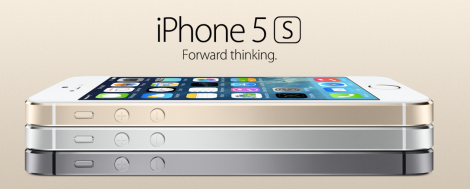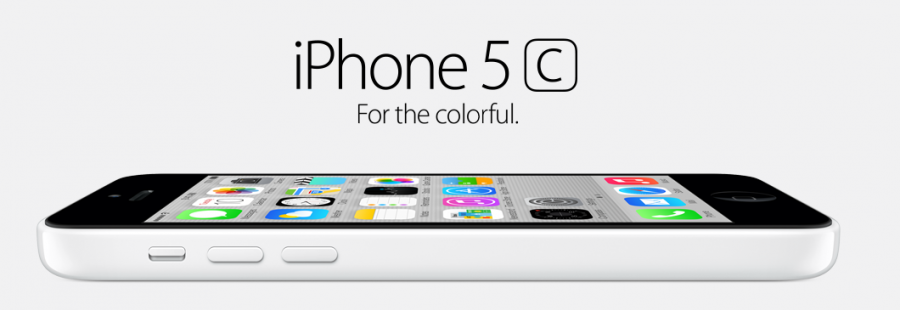Touch-a, Touch-a, Touch-a, Touch Me
This week Apple ended months of speculation and rumours by, as expected, announcing not one, but two new iPhone models.  The iPhone 5C (The C could either stand for colourful or cheap – I guess that depends if you’e an Apple or and Android fan) is being dubbed the replacement for the original iPhone 5. This cheaper model has an all new look and rather than being available in black or white you can now get your iPhone in a range of five different colours. The model also has a (much needed) updated battery, an improved FaceTime camera and will now work on more LTE bands than any other smartphone. The main attraction to the Cupertino event nevertheless was the anticipated arrival of the iPhone 5S. The sheer volume of technology packed into such a small device was enough to wow the 800 strong crowd in the intimate Apple Campus auditorium. Some of the main changes to the new iPhone are the updated camera, new processor power and the inclusion of a new finger print scanner to unlock your phone.
The iPhone 5C (The C could either stand for colourful or cheap – I guess that depends if you’e an Apple or and Android fan) is being dubbed the replacement for the original iPhone 5. This cheaper model has an all new look and rather than being available in black or white you can now get your iPhone in a range of five different colours. The model also has a (much needed) updated battery, an improved FaceTime camera and will now work on more LTE bands than any other smartphone. The main attraction to the Cupertino event nevertheless was the anticipated arrival of the iPhone 5S. The sheer volume of technology packed into such a small device was enough to wow the 800 strong crowd in the intimate Apple Campus auditorium. Some of the main changes to the new iPhone are the updated camera, new processor power and the inclusion of a new finger print scanner to unlock your phone.
The launch of the two new iPhones are always going to be headline news, but what the bloggers & Apple aren’t telling you is that after the
revealing of the cost of the 5C which was being billed as the ‘cheap’ alternative isn’t as cheap as everyone thought it would be. Apple revealed the price to be $150 more than most companies were anticipating, this has lead to a slump in Apple’s stock price by a large margin of 5.4%, which obviously is bad news for any company. Should Apple be worried? After a launch, investors and shareholders should be excited by future prospects, not worrying about losing money, this means measures have to be taken if they want to capitalise on their new products and push up their stock price. All the business bullshit aside, I want to look into the two major changes that Apple have made that are actually more important than what the news stations and online blogs are reporting on.
 Now we all know iWork as “Apple’s version of Microsoft Office” but this could all be about to change. Schools all over America are now using iPads in their classes and now that Apple have announced all of their iWork apps are free to everyone a lot more children will be using them and will now grow up interacting with the interfaces and learning how to develop their education using these Apple created apps. Everybody who used a computer before 2008 would’ve have been able to use the Microsoft products and it was used all over the world. Things even became synonymous with the products; any type of presentation would be known as a ‘Powerpoint’ and nearly every regular document would be written on Microsoft Word. So have Apple finally cracked the code to becoming the industry standard software developer? I think so. Businesses are introducing iPhones to replace Blackberries to their staff and now even iPads are replacing PC’s, as the iCloud feature works so seamlessly it is much more efficient than using different programmes for different devices and emailing them across etc. Apple has just made the whole process quicker and much more systematic which could be disastrous for Microsoft. Initially this looks like a huge business mistake on Apple’s part as they are now losing out on $10 for every app downloaded but if you look deeper then you can see into the huge thought process gone into this whole idea. As I believe these apps will soon become industry standard people will have to buy them for PC so that their own computers are compatible (just as first time Apple users had to buy Microsoft Office once upon a time).
Now we all know iWork as “Apple’s version of Microsoft Office” but this could all be about to change. Schools all over America are now using iPads in their classes and now that Apple have announced all of their iWork apps are free to everyone a lot more children will be using them and will now grow up interacting with the interfaces and learning how to develop their education using these Apple created apps. Everybody who used a computer before 2008 would’ve have been able to use the Microsoft products and it was used all over the world. Things even became synonymous with the products; any type of presentation would be known as a ‘Powerpoint’ and nearly every regular document would be written on Microsoft Word. So have Apple finally cracked the code to becoming the industry standard software developer? I think so. Businesses are introducing iPhones to replace Blackberries to their staff and now even iPads are replacing PC’s, as the iCloud feature works so seamlessly it is much more efficient than using different programmes for different devices and emailing them across etc. Apple has just made the whole process quicker and much more systematic which could be disastrous for Microsoft. Initially this looks like a huge business mistake on Apple’s part as they are now losing out on $10 for every app downloaded but if you look deeper then you can see into the huge thought process gone into this whole idea. As I believe these apps will soon become industry standard people will have to buy them for PC so that their own computers are compatible (just as first time Apple users had to buy Microsoft Office once upon a time).  So Apple can take advantage of PC users by charging a fraction of the price of Office. Apple also knows that customers in computer stores will now know that iWork is taking over and will chose to buy a Mac over a PC (which they should’ve done anyway) thus subtly increasing sales of mac products as well as iOS devices.
So Apple can take advantage of PC users by charging a fraction of the price of Office. Apple also knows that customers in computer stores will now know that iWork is taking over and will chose to buy a Mac over a PC (which they should’ve done anyway) thus subtly increasing sales of mac products as well as iOS devices.
 Every year Apple release a new processor, so the A7 chip was expected but the chip and the iPhone 5S were not the only pieces of majorhardware that Apple has developed in the last 12 months. The new M7 motion coprocessor chip will be shipped in the new device and has to the potential to radically change the way we use our mobile phones in daily life. The chip itself continuously measures motion data and works seamlessly with the brand new A7 chip to efficiently manage the workload for improved power output. M7 is now constantly measuring gestural date and collecting specific information from the built in accelerometer, gyroscope & compass in the device and it is conglomerated together in a secure database. A new CoreMotion API has also been introduced to aid developers in taking advantage of the chips data to create and revolutionise fitness and health apps. The chip itself is constantly measuring your motion data, even when the device is asleep – now if you are worried about data protection and all that jazz then you have the option to turn it all off and none of the data will be sent back to Apple, if you prefer you act like a secret agent and never give anything away then that’s your call.
Every year Apple release a new processor, so the A7 chip was expected but the chip and the iPhone 5S were not the only pieces of majorhardware that Apple has developed in the last 12 months. The new M7 motion coprocessor chip will be shipped in the new device and has to the potential to radically change the way we use our mobile phones in daily life. The chip itself continuously measures motion data and works seamlessly with the brand new A7 chip to efficiently manage the workload for improved power output. M7 is now constantly measuring gestural date and collecting specific information from the built in accelerometer, gyroscope & compass in the device and it is conglomerated together in a secure database. A new CoreMotion API has also been introduced to aid developers in taking advantage of the chips data to create and revolutionise fitness and health apps. The chip itself is constantly measuring your motion data, even when the device is asleep – now if you are worried about data protection and all that jazz then you have the option to turn it all off and none of the data will be sent back to Apple, if you prefer you act like a secret agent and never give anything away then that’s your call.
I personally think that the M7 chip is an incredible leap into the future of mobile technology even for Apple. Although the A7 chip has taken that one step further into 64bit territory (which now means the iPhone has a chip with desktop-class architecture) it is still only dual core rather than the new Samsung standard quad core. The M7 will revolutionise exercise routines and training methods all over the world and now it’s going to be fun to get fit. But is that all M7 is good for? Apple has failed to capitalise on some great ideas that the M7 chip can be used for rather than just being your personal trainer. M7 could be useful in making everyday life that little bit easier, imagine you park your car in a large parking lot and can’t remember where you left it. The M7 chip remembers that you got out of your car and started walking in the north east corner, 3rd lot from the left 7 hours ago and can give you turn by turn directions back to where you parked, it’s as simple as that. I can hear die hard Apple fans screaming because they know that anything that is constantly running in the background will eat up your battery quicker than a homeless guy at a free buffet, but the chip actually solves that problem. Whilst you’re driving, it will stop looking for Wi-Fi networks and other background processes that take place will also be switched off. Clever right?
 The iPhone 5S is also coming with an updated camera and brand new security technology that lets you unlock your device with your fingerprints. Now these updates are the main reasons why people will be buying the new device so it’s only fair that I talk about these changes as well. The new Touch ID scanner works by scanning the first layer of your epidermis on whichever finger it is you want to use, it then takes a full 360 degree image so that it can read it from which ever position you are holding your device, it’s built into the home button and is now protected by a full sapphire lens. All the
The iPhone 5S is also coming with an updated camera and brand new security technology that lets you unlock your device with your fingerprints. Now these updates are the main reasons why people will be buying the new device so it’s only fair that I talk about these changes as well. The new Touch ID scanner works by scanning the first layer of your epidermis on whichever finger it is you want to use, it then takes a full 360 degree image so that it can read it from which ever position you are holding your device, it’s built into the home button and is now protected by a full sapphire lens. All the  information is encrypted and you are the only person who can access the data. I think that the finger print scanner to unlock your device is interesting, it’s a great selling feature and a great way to advertise on Apple’s part and I’m sure it will also be the cause of many breakups, “he wouldn’t unlock his phone so he must be hiding something from me” and all that jazz. The main feature however for the new ‘Touch ID’ is the Apple ID purchasing tool which lets you use your fingerprint as a password to buy your music and apps on your device, this is much more useful than just having to put a 4 digit code onto your iPhone – as it can stop fraudulent purchases from your account and we may finally see and end to these bloody stories online about how “my son racked up a $500 phone bill playing Candy Crush”.
information is encrypted and you are the only person who can access the data. I think that the finger print scanner to unlock your device is interesting, it’s a great selling feature and a great way to advertise on Apple’s part and I’m sure it will also be the cause of many breakups, “he wouldn’t unlock his phone so he must be hiding something from me” and all that jazz. The main feature however for the new ‘Touch ID’ is the Apple ID purchasing tool which lets you use your fingerprint as a password to buy your music and apps on your device, this is much more useful than just having to put a 4 digit code onto your iPhone – as it can stop fraudulent purchases from your account and we may finally see and end to these bloody stories online about how “my son racked up a $500 phone bill playing Candy Crush”.
The new camera is actually a breath of fresh air, for iPhone veterans like myself you will know that taking photos in a dark place such as a nightclub can be a disaster, the lighting is all off, your skin tone looks really pale and no editing software in the world could fix that redeye. This is all set to change with Apple’s new ‘truetone’ dual LED flash, it uses two flashes; one yellow and one white to create over 1,000 different variations of light to take the perfect photograph. This all new mobile technology also includes DSR level autofocus and auto image stabilisation, this works by taking 4 photos a second and merging them together to get the best possible image all done automatically without you even seeing the original images. These real time edits and ‘truetone’ flash are a mobile device first and Apple has raised the bar higher by announcing that rather than increasing the megapixels they have increased the size of the pixels themselves. Bigger pixels are a better pixel as they allow for more light, less noise and a much more vivid colour output, all this put together could revolutionise even further the way in which we use our iPhones as cameras. 
iOS7 is on the brink of release and with the two devices both launching on the 20th September we can expect to see countless Tweets and status updates either about problems with it or how much they love it, because at the end of the day, Apple is a company that you either loath or love. People are already talking abut the iPhone 6 and iOS8 – they can speculate about holograms and retina scanners all they want, I’m just going to cut my finger off and keep it in a safe place and wait for this all to blow over.

Sam Neve is junior international student from Great Britain studying Journalism. He has an eclectic taste in both music and sports and enjoys going to...








